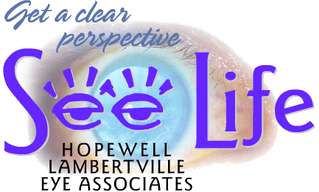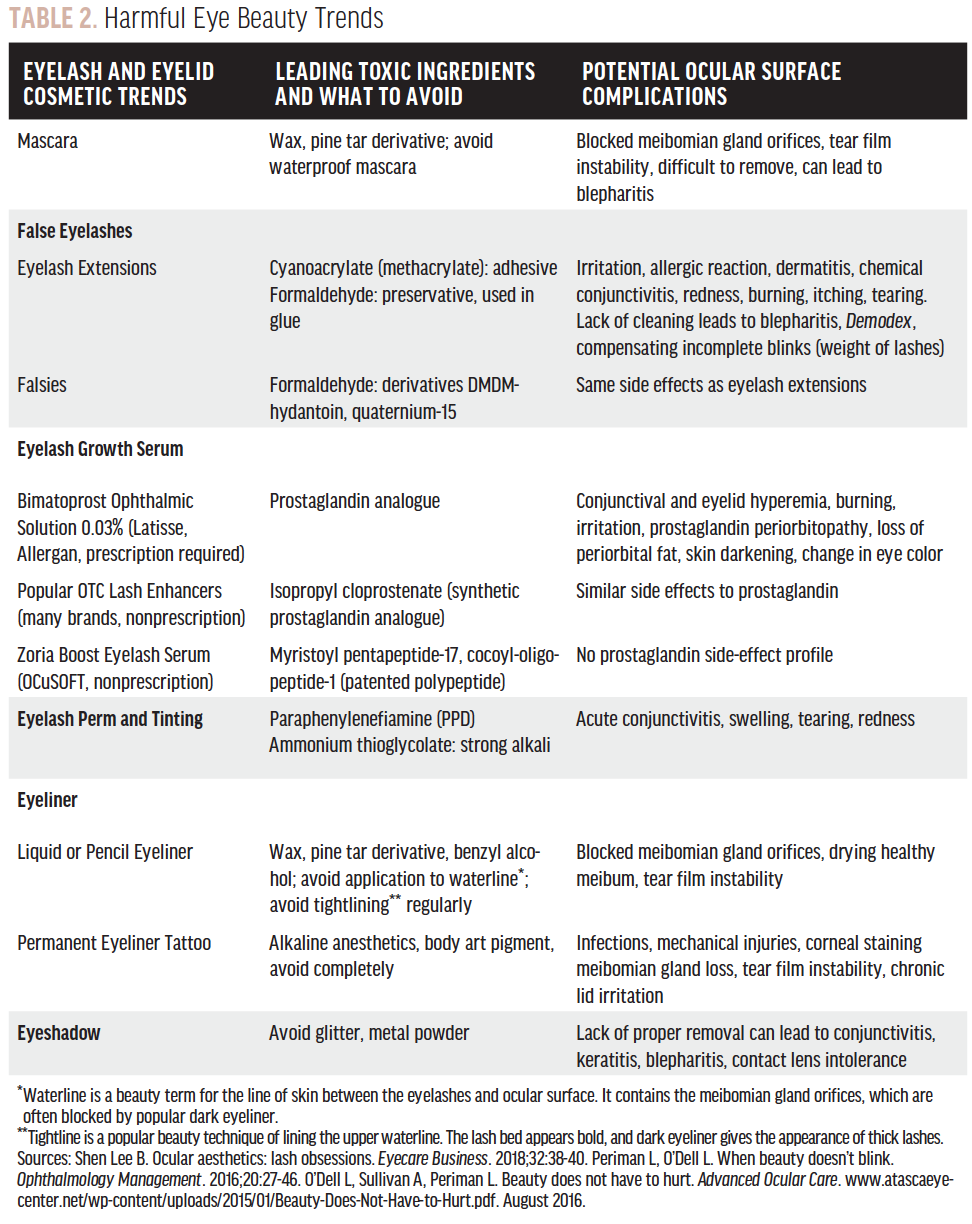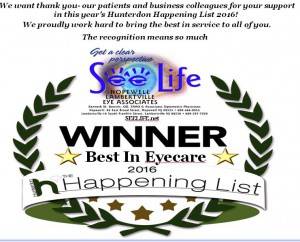Cosmetic Use and Ocular Complications
Beauty products are not as harmless as they seem.
The use of eye cosmetics represents a lifestyle challenge. Eye cosmetic products and/or procedures may be associated with multiple adverse effects. These may cause harm and/or exacerbate or promote the development of ocular surface and adnexal disease. Common eye cosmetic product complications are well established, and include lead toxicity, conjunctival and periocular pigmentation.. leading to eye cosmetic wearers toward tear film instability and dry eye development.6,7,13–15 ….
Ever look at an ingredient list on a box of mascara and wonder what ingredients should be avoided for sensitive eyes? Many of the cosmetics on the market claiming to be safe for sensitive eyes are not. The ingredients in these products can increase your eyes’ sensitivity … and it's not always easy to decipher the good versus the ugly.
Furthermore, this phenomenon is also thought to contribute toward some of the reported adverse effects associated with eye cosmetic wear, including posterior blepharitis, ocular surface irritation, tear film instability, conjunctival pigmentation, corneal epithelium inflammation, and keratitis.2,7,16–19
Eye cosmetics, or makeup, comprise a diverse array of products. They include concealers, conditioners, creams, extensions, eyeliners, foundations, glues, mascaras, primers, removers, serums, shadows, and toners. These products may be either leave-on or rinse-off. Leave-on products are those intended to stay in contact with the skin for a certain period of time; rinse-off products are applied and removed soon afterwards [1].
A number of the ingredients in these products may act as allergens, carcinogens, endocrine disruptors, immunosuppressants, irritants, mutagens, toxins and/or tumor promoters, and may damage the ocular surface and adnexa.
In addition, there are numerous cosmetic procedures for the eye, including eyelash curling, dyeing, tinting, and perming, botulinum toxin, filler and platelet-rich plasma injections, chemical peels, conjunctival tattooing, eyelid piercing and tattooing, micro-dermabrasion, micro-needling, and skin resurfacing and tightening. A number of these procedures may also be associated with adverse ocular events.
Ten beauty agents - cosmetics - lash enhancements causing eye damage : Noting the inexperience and lack of knowledge by the individual distributing the products and / or applying them.
- Waterproof eye makeup
- Drug store and department store liquid eye makeup removers
- Eyelid tattooing
- Eyelash extensions
- Eyelash tinting and eyelash perming
- OTC eyelash growth serums
- Argireline, acetyl hexapeptide-3 and acetyl hexapeptide-8 (“Botox-in-a-jar”)
- Botulinum toxin injections for crow’s feet
- Retin-A and most anti-aging creams
- Eyeliner on the lid margin (“tightlining”)
Eyeliner products are commonly applied to the periocular skin, immediately adjacent to, but external to the lash line (Figure 1A) or directly onto the lid margin at the mucocutaneous junction, also known as “tightlining” (Figure 1B).
Most patients are unaware that the eyelid margins contain the meibomian gland terminal ductules, which are important oil gland openings for delivering protective oils to the tear film.
However, trending makeup application techniques such as waterlining or tightlining often block meibomian gland orifices and introduce chemicals that may interfere with ocular health. Eyeliner applied on the inner portion of the lash line has been shown to migrate into the eye 15% to 30% of the time.6 Patient education is paramount in changing this ubiquitous and harmful beauty trend.
Figure 1 Clinical examples of periocular and inner lash line eyeliner application, highlighting the migration of cosmetic product onto the lid margin and onto the interpalpebral ocular surface are shown in Figure 2.
Eyeliner applied to (A) the periocular skin of the lower eyelid, external to the lash line and (B) to the surface of the lower eyelid margin, within the lash line (“tightlining”).
The migration of cosmetic products across the eyelid margin may potentially contribute toward an increase in debris within the surface tear film lipid layer, in meibomian gland blockage, and in meibum contamination.11,12,15 The resulting destabilization of the lipid layer can lead to increased tear evaporation and reduced tear film stability.6,7,14,24
The use of preservative agents in OTC cosmetics and ocular toxicity:
PRESERVATIVES FUEL THE OSD FIRE (ocular surface disease)
Parabens are another category of preservative commonly used in over the counter (OTC) skin care (both men’s and women’s products). Parabens are also prevalent in cosmetics (eg, butylparaben, methylparaben, propylparaben). Not only are these xenoestrogens believed to penetrate the skin and potentially disrupt hormone function, but they are nearly as toxic to human meibomian gland epithelial cell culture as BAK.2
The potential role of preservatives used within eye cosmetic formulations has also been raised. A review suggested that benzylalkonium chloride (BAK), a quaternary ammonium preservative, may contribute toward lipid layer destabilization through its detergent-like tensioactive effects.7 However, it is noted that BAK is no longer widely used in eye cosmetic products, partly due to its reduced preservative efficacy within formulations containing solid particulate matter or ionic emulsifications.29
Increased Infection Rate with Cosmetics
There is an increased risk of ocular infection with microbial contamination of the products, which may arise from multiple sources, such as during the manufacturing process, reduced preservative efficacy with the age of the product, and shared use of cosmetic products amongst multiple users.36–39
Ocular Demodex mites have a high affinity toward oil-rich environments, such as the meibomian glands, and may also survive in oil-based cosmetic products and applicators.6 Corneal trauma is a recognized potential complication from the use of mascara applicator wands (Figure 4).40–42
Increased Risk of Ocular Inflammation - Trauma
Eyelid dermatitis and ocular surface irritation can also occur in response to several constituents within eye cosmetic formulations including fragrances, preservatives, antioxidants, emollients, resins, nickel-containing pigments, and pearlescent additives.43,44 In addition, posterior blepharitis, ocular surface irritation, conjunctival pigmentation, and keratitis have also been reported in association with eye cosmetic wear.2,7,16–19
Corneal abrasions induced by a mascara wand, observed under blue light following sodium fluorescein instillation.
Effects on ocular comfort
The adverse impact of eye cosmetic products on tear film stability would suggest that their use is associated with poorer ocular comfort and dry eye symptomology,11,12,14,28 although, it has been acknowledged that eyelid hygiene regimens and digital manipulation associated with routine removal of cosmetic products may potentially introduce confounding effects.4
Dry eye treatments in eye cosmetic wearers
Dry eye disease is one of the most commonly encountered ophthalmic conditions in clinical practice, and is recognized to have significant effects on vision, ocular comfort, and quality of life.46 Epidemiological studies have consistently reported a higher prevalence of dry eye among females.47 Furthermore, there is thought to be an increased propensity for eye cosmetic wearers to develop symptoms of dry eye, due to the reduced tear film stability and lipid layer quality associated with the migration of periocular cosmetic products across the eyelid margin.6,7,13–15
Eyelash Extension and Ocular Complications
Normal eyelash length is one-third of the width of the eye opening, enabling optimized ocular surface protection from allergens, dust, debris, and air flow.7 When the lashes are abnormally lengthened, this important protective mechanism is lost.

Figure 1. Marked allergic and chemical conjunctivitis (A) after improper application of eyelash extensions applied to superior line of Marx (B) one day prior, blocking meibomian glands. This patient had to have the false lashes removed immediately due to her severe ocular symptoms.
ALLERGY AND INFLAMMATION
Eyelash adhesives are cyanoacrylate- like adhesives that often contain methacrylates, volatile organic compounds, and the well-known preservative and ocular irritant formaldehyde.9 The chemical cocktails used in many ocular cosmetics add to the risk of allergy for our patients, often presenting as contact or atopic dermatitis.
Additionally, these chemicals can leach into the ocular surface during application, creating a chemical conjunctivitis or chemical keratitis (Figure 2). Even nail polish and acrylic fingernails can cause chronic dermatitis in patients because many contain high levels of volatile organic compounds and formaldehyde.

Figure 2. This patient presented with significant blepharitis and complaints of dry eye 2 weeks after application of eyelash extensions. The patient admitted to discontinuing eyelid hygiene to prevent damage to the extensions.
ISSUES SPECIFIC TO CONTACT LENS WEARERS
Mascara can be mechanically and chemically irritating if it flakes into the tear film. For contact lens wearers, these flakes can become trapped under a lens, causing corneal erosion.15 Many pigments used in eye makeup are non-dissolving, and hard particulates can become lodged under a contact lens and scratch an unprotected ocular surface.
The use of Anti-oxidants in Skin Care - Reactive Oxygen Specifies (ROS)
The way the aging process happens isn’t fully understood, but there is evidence that oxidative stress plays a role. Reactive oxygen species (ROS) does increase with age, sun exposure, smoking, pollutants, genetics, autoimmune diseases, and other lifestyle factors. When there is too much oxidative stress, there is an increase in free radicals, and antioxidants cannot fully neutralize this effect, creating an imbalance. This imbalance is when ROS are produced. ROS are highly unstable and reactive molecules and can have detrimental effects on the body. We see this in patients with AMD (age related macular degeneration) , DED (dry eye disease), cataracts, glaucoma and in aging skin.
Vitamin C or L-ascorbic acid is an efficient water-soluble antioxidant that can neutralize free radicals both intracellularly and extracellularly. Vitamin E or a-tocopherol is a lipophilic antioxidant that serves as a protective agent for different components of the skin. Retinoids are derivatives of vitamin A, which promote skin cell turnover. There are various forms of retinoids that are commercially available, including retinol esters, retinol, retinaldehyde, and retinoic acid. Retinoic acid (tretinoin) is the most bioactive available and is the only derivative of vitamin A,
Sunscreen, antioxidants, and caffeine can all be valuable components of a skin care routine. Sunscreen provides protection against harmful UV radiation and reduces the risk of skin cancer and skin aging. This is the easy one to discuss. Caffeine offers anti-inflammatory benefits alongside vasoconstriction, which aids in puffiness. Antioxidants can help combat ROS and promote collagen production through cell turnover. Understanding the scientific research helps put us in the driver’s seat when educating patients about what products can be helpful, those that can be harmful, and those that make claims with no supporting evidence.
American Academy of Dermatology recommends that sunscreen should be at least SPF 30. Sunscreen, antioxidants, and caffeine can all be valuable components of a skin care routine. Sunscreen provides protection against harmful UV radiation and reduces the risk of skin cancer and skin aging. This is the easy one to discuss. Caffeine offers anti-inflammatory benefits alongside vasoconstriction, which aids in puffiness. Antioxidants can help combat ROS and promote collagen production through cell turnover. Understanding the scientific research helps put us in the driver’s seat when educating patients about what products can be helpful, those that can be harmful, and those that make claims with no supporting evidence.
In Summary
It is important that the consumer to know how to identify and understand the proper use and selection of cosmetic products that can potentially lead to ocular surface disease complications related to eye beauty trends1 (see Table 2).
Tips for Good Ocular Health and Cosmetics: FIVE HEALTHY EYE BEAUTY HABITS
- Obtain baseline ocular surface exam findings before getting eyelash extensions.
- Always remove makeup and wash your face and eyelids before going to bed.
- Do not tightline or apply eyeliner over your waterline.
- Avoid waterproof makeup if possible; do not use on a daily basis.
- Do not use over-the-counter “take the red out” eye drops without first treating the underlying cause of your red eyes.
BUYER BEWARE
Our patients’ beauty practices can wreak havoc on the ocular and dermal surface. We use and endorse products which are plant-based, natural, organic, vegan, and ophthalmologist-tested equate to ocular and dermal surface safety.
As such Hopewell Lambertville Eye offer cosmetic products that have been clinically tested and are absent of any toxic agents.
Our patients need to be aware of the potential adverse effects associated with the use of eye cosmetics and antiaging products. Educate yourself about the latest trends, and discuss beauty routines with our staff, regardless of their gender.
To purchase safe - ophthalmic tested nutraceuticals, natural beauty and cleansing supplies visit the Hopewell Lambertville Eye (www.seelife.net) – use click on the Dry Eye Rescue icon (use promo code Hopewell10 or Lambertville10) when registering or the Online Store Icon https://seelife.myeyestore.com/
Hopewell Lambertville Eye Seelife MyEyeStore Dry Eye Rescue: Promo Code: Hopewell10 Lambertville10
Direct and Modified text from the following sources:
https://www.ncbi.nlm.nih.gov/pmc/articles/PMC6118859/
https://dryeyemaster.com/cosmetic -use-and-dry -eye/
https://modernod.com/articles/2020-july-aug/managing-ocular-surface-complications-from-harmful-eye-beauty-trends?c4src=article:infinite-scroll
https://www.ophthalmologymanagement.com/issues/2019/april-2019/the-everyday-cost-of-eyelash-makeup
https://reviewofpresbyopia.com/lotions-and-potions-conquer-your-cosmetics-conversations-with patients/?utm_source=WhatCountsEmail&utm_medium=Review%20of%20Presbyopia%20and%20the%20Aging%20Eye&utm_campaign=ROP_FeatureFocus_122223
TFOS Lifestyle: Impact of cosmetics on the ocular surface (tearfilm.org)












